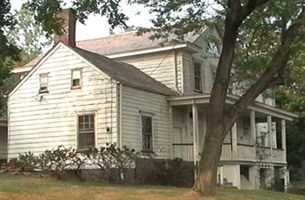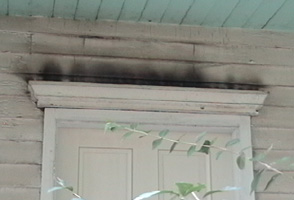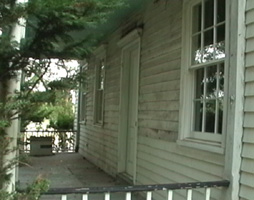

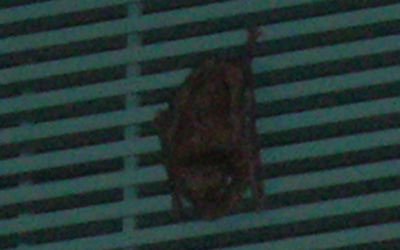
Account #1
The infamous Graduate School of Education (GSE) building, which holds the Rutgers Rarities
record for number of unexplained phenomena, was officially investigated for the first time,
and it did not disappoint. It just so happened that on the day we arrived, we were told
by our guide Brent that we were about to be witness to the first bat he had seen in the
building in over two years. Of course, there had been many sightings by others over the
course of those two years, but this was a little more than a coincidence that our
investigation was set to take place on that fateful day. While this is just a short
"Investigations" entry, a full account will be added in its entirity to the
Accounts page.
When we arrived at the scene, Brent reported that the bat had flown at him as he walked through the second floor hallway that night, and that the bat musut still be there. We discovered him hanging from a vent above one of the doorways on the second floor. Soon enough, he was flying to and fro across the L-shaped hallway. We took our positions in the stairwell, which luckily had two windows from which we could capture the action from the front row. I positioned my camcorder directly against the window, as the bat made several passes. On one particular pass, he came directly for my head, with only a single pane of glass separating us. The frame shows the bat in full extension, and the slow-motion animation shows the close encounter. Apparently the old adage still holds true that when you look for trouble, it will find you. In the case of Rutgers Rarities, we'll always be looking, so check the "Investigations" page often to see what finds us.
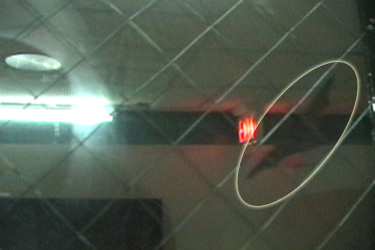


Account #2 - Rabby, the Evil Knievel of the GSE
Who's blind, fast, and has a penchant for pesky paranormal investigators? It's our good friend "Rabby" the swinging, winging bat of the GSE, that's who. Actually, unlike some of his foaming brethren, Rabby doesn't seem to be the slightest bit rabid, but there's no discounting this bat's desire to hook his claws into a certain mop-headed Rutgers Rarities investigator. Along with co-investigator Ray, I stood amazed while this aerial deviant repeatedly attempted to swoop and dive, claws-first at our faces through a glass window. I comfort myself with the knowledge that the crazy beastie actually seemed to be aiming for Ray and did not show much interest in pursuing me despite some feeble attempts to record his awesome wingspan in the long, dark halls of the GSE. I think "Rabby" hungers for you Ray...best keep your hair cut short and watch your back after dark.
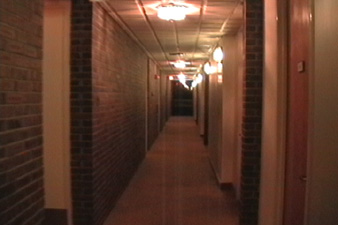
With nothing more to go on than a hunch, this impromptu investigation turned into what is now the cornerstone of Rutgers Rarities. On a whim, the crew stopped by the University Inn and Conference Center, and was greeted by a most gracious host named Val at the front desk. She proceeded to take us through the history of the building, which became an inn in 1965 when it was acquired by Rutgers. The building was originally constructed in 1848 and named "Lindenwood". It was built for Sydney Bleecker Carpender and his wife, Louise Johnson, daughter of James Wood Johnson (one of the founders of Johnson and Johnson). An addition to the original building was constructed in 1969, and the old and newer wings together make up the University Inn and Conference Center.
After inquiring about any strange or unusual phenomena that Val had come across at the inn, she casually answered that the third floor was haunted - the new wing by a female spirit believed to be Louise Johnson and the old wing by a male spirit believed to be Sydney Carpender. We made our way up to the third floor of the new wing in anticipation of our potential first encounter with a presence. The third floor seemed to have a life of its own. My personal experience occurred while walking down the hallway and filming with my camcorder. As I walked through, I felt a sudden and deliberate pulling, as if a force had physically grabbed my camcorder and pulled it towards my body. I tried to resist the force, and my hand slid to the front of the strap. During filming, the camera tilted and pointed upward as I pushed the camcorder away in resistance. The force was strong enough for me to struggle against it. As it happened, I tried to justify it by telling myself it must be some air current, but in hindsight, I realized that that explanation was impossible. It was the first time I had ever encountered any experience of that nature, and it certainly made me a believer.
As we rounded the corner, there were several more strange occurrences. There was a tapping from behind the door of room 335, and we had been informed by Val that there were no guests booked in that wing for the night. There was a light on in room 336, also in the same part of the hallway. Jessica's tape recorder shut off periodically, and yet experienced no mechanical problems before we got there or after we left. Val mentioned that many guests had reported strange activities and the presence of a spirit around the area where we were experiencing those oddities. Some even reported catching a glimpse of a female spirit in peripheral view as they rounded a corner. We were not the first to experience such phenomena, and I don't think we'll be the last. The University Inn will be further investigated as a Rutgers Rarities hot spot, and we must once again thank Val for her aid and assistance. This particular investigation has been included as a full Rutgers Rarities Account.
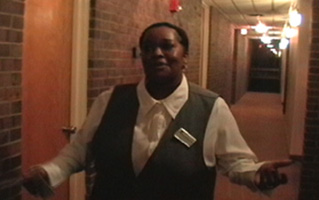
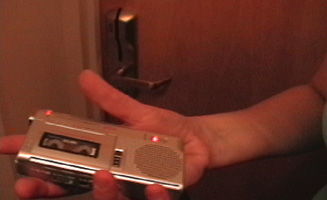


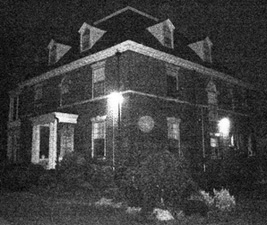
In the 1920's, and until the Lindbergh baby kidnapping in 1932, the Hall-Mills Murder case, nicknamed "The Minister and the Choir Singer", was dubbed the crime of the century. To this day, it remains an unsolved case. According to the Crime Library account, it was a tale of murder, lies, deceipt, and cover-ups. The address 23 Nichols Avenue was listed as the residence of Reverend Edward Wheeler Hall, the famous minister who was having an open affair with the married Eleanor R. Mills. The suspects were many, the family members who disapproved, the jealous and/or angry parrish members of St. John's Episcopal Church, the media hungry locals. Among the suspects were Frances Noel Stevens, the rich wife of Reverend Hall who was related to the prominent Johnson and Johnson family, her brother Willie Stevens, a 50-year old dependent suffering from mental problems, her other brother Henry Stevens, a 52-year old expert marksman, and her cousin Henry Carpender, who lived two residences away from the Hall House. Others accused the Ku Klux Klan, a hired assasin, and Eleanor's husband James among others. There were paid off cops, including a dirty one who was serving time in Alcatraz, the infamous "pig lady" who accused Carpender, claiming to have heard the shots and seen the whole thing go down (later accused as a liar), the incompetent investigators at the scene who allowed the public to handle key evidence, the multiple autopsies, and the outrageous trials - and then there was the murder scene. Reverend Hall and Eleanor Mills were laid out in full attire under a crab apple tree on De Russey's Lane, which also happened to be Lover's Lane. They were discovered several days after the murder, with shredded love letters between the two scattered about the bodies. He was shot in the head once and her three times, in addition to her tongue being cut out and her throat being slit from ear to ear.
The residence of Reverend and Frances Hall at 23 Nichols Ave is now the residence of the Dean of Douglass College at 23 Nichol Ave. With so many of the suspects acquitted of the crime, it is still a case that draws much discussion. If one of the members of the Reverend's household, such as Frances Hall or one of her brothers (or some combination of people) did commit the murder, some believe that the weapon is buried within the confines of the household, possibly in the walls after the house was reconstructed. Reverend Hall is currently buried next to his wife in Green-wood Cemetery in Brooklyn, NY, while Eleanor Mills is buried next to her husband James and daughter Charlotte at Van Liew Cemetery in New Brunswick, NJ. It is ironic that Nichol Ave is the same street as the Little Theater, which is being investigated by Rutgers Rarities as a site of hauntings.

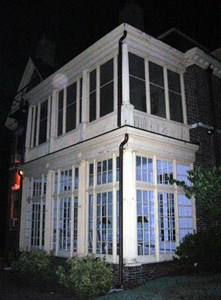
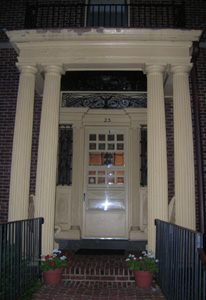
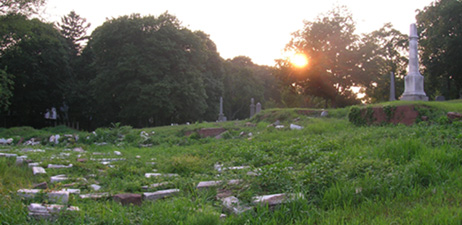
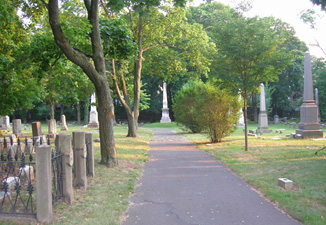
The second section is the Willow Grove Cemetery itself, which was established in 1851. This region used to contain temporary underground holding vaults for deaths that occurred in the winter months. The Japanese section of Willow Grove was built as a burial plot for eight of the first Japanese exchange students ever to study and work in America. According to a Rutgers Rarities source, pnemonia claimed the lives of these students. An unknown World War I soldier stationed at Fort Dix was buried in 1930 with full military honors in the Willow Grove section as well. Many notable names, including Catharine Bayard Rutgers (widow of Theodore Grant Neilson), Cornelia Rutgers, former wife of Hardenbergh, both possible descendants of Henry Rutgers, and previous Willow Grove Cemetery landowner, Ira Vorhees, are buried in this section as well.
The Cheesman, or Central, Cemetery was established in 1868. Much less is known about this section of the cemetery, except that its most notable resident is Jeptha Cheesman, former mason, leader, and landowner.
Buried over the three cemeteries, there are seven former New Brunswick mayors, one US Senator, one House of Representatives member, many civil war heroes, and other notable locals. Directories and maps of the cemetery can be found at the Willow Grove Cemetery Official Website, where much of this information was found.
This cemetery was explored by Rutgers Rarities, and several interesting things were noted. There are a series of groundhogs present in the cemetery that seem to have made their home among the tombs, with underground tunnels running around and between the graves. A tree was found in the center of the cemetery that was apparently struck by lightning. There were a great number of vandalized tombstones. An article in Rutgers' Daily Targum was written about vandalism in the cemetery. It looked as if a flood had washed the loose stones and grave markers into the Presbytarian Cemetery section, since there were only eight or nine unmarked tombstones still erect in this lower region. There were many odd tombstones simply marked "Mother" or "Father", with no further information. The cemetery is located across the street from C-Town, behind the Henry Guest House, and next to the brand new Rutgers housing building constructed this year. As students leave the parking deck, they will come face-to-face with the graveyard.
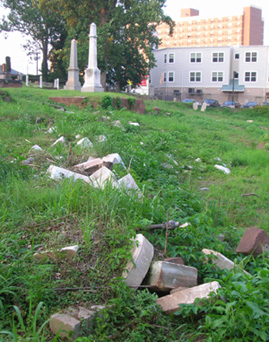

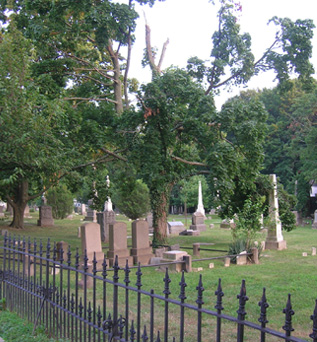
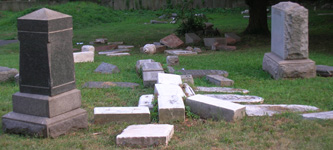
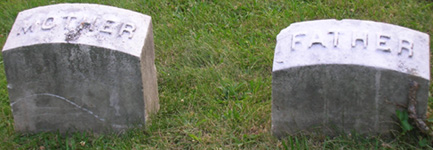
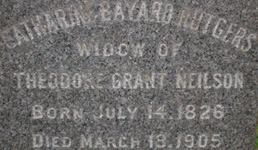

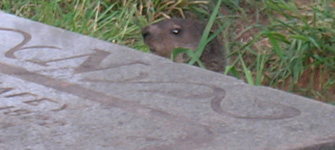
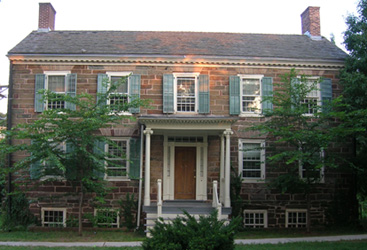
According to the sign out front, the Henry Guest House was built of local stone by Henry Guest in 1760. Guest lived at this sandstone house until his death in 1815. According to the New Brunswick Free Public Library Site, Henry Guest was quoted to have said "If his descendants would only keep a roof on it, the house would stand till Gabriel blew his trumpet". According to Historic New Brunswick, Guest was an associate of President John Adams and author Thomas Payne, who once stayed at the residence.
Besides the daredevil squirrel on the roof, nicknamed Ethan Hunt for his "Mission Impossible"-like tactics, the house seemed relatively quiet and uneventful. It has recently been locked up and boarded down. It's candidacy as a local favorite for spirits is promoted by its location, as the Willow Grove Cemetery is in its backyard.
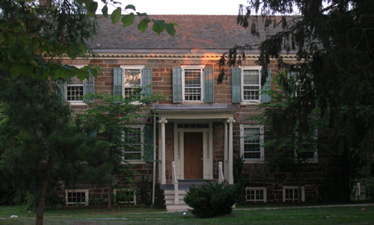

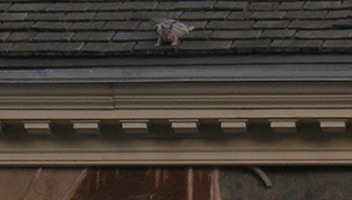
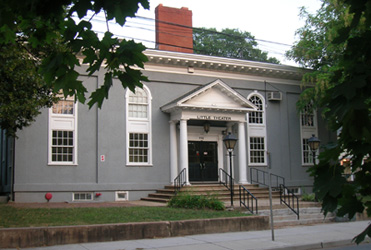
On Douglass Campus off of Nichol Avenue (#112), there is a small playhouse wedged in the between the horseshoe that makes up the first set of Rutgers' Corwin residence halls. This phenomenon of this theater was found by Rutgers Rarities in an account by the Midnight Society. The entire account reads:
The Little Theater, at Douglas College in Rutgers university, is an old theater that is said to be very haunted. It was closed down years ago becuase the beams from the lights fell down during a performance. Some say the Little Theatre was deemed an unsafe performance space even though it still has many rehearsals and classes held there, sometimes late into the night. I have heard several accounts of people seeing an old woman ghost and hearing her sing and play an old piano. The legend is that this woman really liked the theater that she moved her appartment into the second floor of this small theater. The legend then states that she hardly left the building while she was alive. And she is still there spiritually, or so the story goes. The truth is that her bathroom and some of her living space still remain. This is a very creepy space and even if it is not as haunted as people claim it is still rich with history.
A Midnight Society reader from Rutgers offers an account:
I go to School On the Rutgers Campus. And I am also apart of the "Little Theater". We were having a Conert rehersal around 6:30p.m. All of a sudden one of the lights mysteriously falls down on the stage. This was very strange for us, because it never happened before. The story goes that this one lady that really loves the Theater stayed there and when I mean that she stayed there she literally stayed there. Even her Spirit. And she doesn't want anybody in This Theater. That's how much she loves this place. Anotherwards if she can't rest than nobody can. It is very disturbing but we have to deal with it. You can visit this theater any time you want to even at night.
Armando - Elizabeth
During the initial Rutgers Rarities investigation, the Little Theater was locked up, so this location will be explored once again during the school year. One notable detail was a high window pain containing some strange markings, like a hand had been swept across it. Thanks to the Midnight Society for first uncovering this interesting phenomenon.
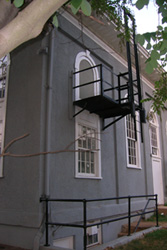
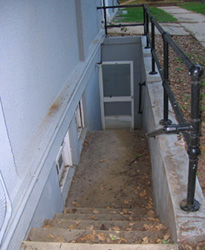
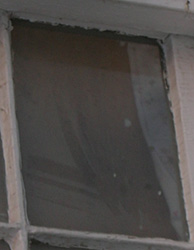

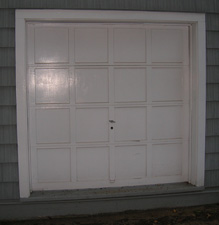

The Middlesex Sampling Plant and Municipal Landfill facilities were utilized as part of the Manhattan Project to create the atomic bomb, as detailed on the X-Factors page. At the time, there were no good ways of dealing with the disposal of extraneous radioactive materials, so they would be stored at the plants where the raw materials were processed. With the high volume of waste involved in processing the 154 tons of African pitchblende ore to generate high-radium-content materials, there was nothing more to do than keep everything in containers or pile up the contaminated dirt. Up until very recently, two massive contaminated radioactive dirt piles were stored at the former site of the Middlesex Sampling Plant on Mountain and South Avenues. The dirt was collected from suburban areas around the Sampling Plant, including a nearby church and a dozen homes in 1984. Since the plant was established in 1943, it took 41 years to acknowledge and gather contaminated dirt at homes and churches. It took another 15 years to start a clean-up project to move the radioactive dirt from the site. The $90 million clean-up project began in 1999 and took more than three years, moving the materials to radioactive treatment facilities in Pennsylvania. If ninja turtles can spawn from radioactive material, I don't even want to think of the possibilities of the effects contamination on that large a scale can have. Though the barbwire-protected area no longer contains heavy volumes of contaminated soil, there are still various containers and remnants of the Manhattan Project test facilities. It kind of makes you wonder about the implications of large-scale contamination in the suburbs over the course of more than 50 years, and how it changed the people, places, and environments during this time.
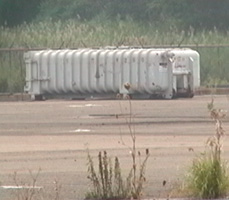

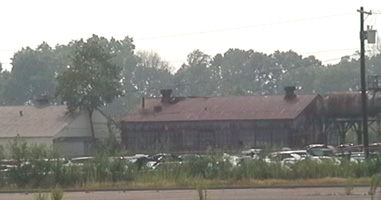
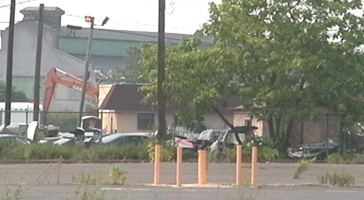
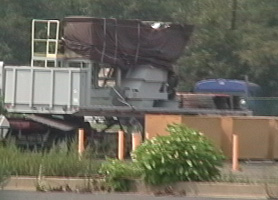

The former site of Union Carbide in Piscataway is a desolate wasteland. Though Dow Chemical, which merged with Union Carbide in 2001, and other nearby facilities are still in full operation, Union Carbide remains a shadow of its former self and the grounds are an empty shell. In the 1920's, the facility produced Bakelite phenolic, the first true "plastic" in the world. Along with the positives involved with developing these materials, however, the Piscataway plant (to some degree) and the other plants worldwide (to a larger degree) began to develop a bad environmental reputation.
According to Endgame Research Services, in the 1950's and 60's, 1/3 of the world's mercury was brought to the Oak Ridge Union Carbide facility in Tennessee, and more than 2.4 million pounds were left unaccounted for. Much of this material is believed to be buried under buildings, while hundereds of thousands of pounds were leaked into a creek and into the air. The site documents air pollution, spills and leaks, and numerous explosions and accidents that caused death and illness to innocent employees and locals. At the Piscataway site, there were often reports of injuries and deaths at the facility, almost on a daily basis. There was also a reported fire that claimed the lives of many workers. However, there was no greater Union Carbide accident than in 1984, when according to Common Dreams News Center, "40 tons of poisonous substances leaked from Union Carbide's (now Dow's) pesticide plant in Bhopal, central India. A huge yellow cloud exposed a half million people to the gases, which hung over the city for hours. It remains the worst industrial accident of all time, with an estimated 7,000 deaths and 190,000 injuries the first few days and over 15,000 claims of deaths to date".
The Piscataway Union Carbide facility closed its doors in 2004, and the desolate land surrounding the area is eerily quiet, with no signs of growth or life. It leaves one wondering about the chemical activities that went on through the years and how they affected the immediate landscape. A few bags of medical waste were discovered out back, containing used gloves and chemicals. The building is covered inside and out with graffiti, with threats and warnings to those who even think of entering. There is still ongoing talk about what to do with the land and what to build, but the sad spirit of the broken facility seems like it will always remain.


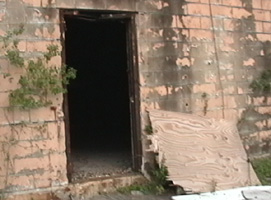


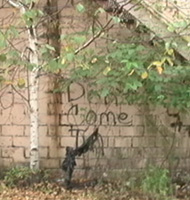

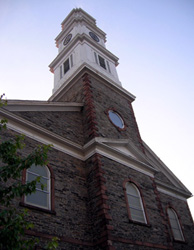

There are two main church graveyards on Nielson and Paterson Streets across from the Hyatt Hotel in New Brunswick. The First Reformed Church is a Dutch Reformed Church, and one of the first in New Brunswick. This makes sense because the Dutch Reformed Church was responsible for the initial establishment of Rutgers. The church itself was organized in 1717, and the leaders of the church were among the first signers of the charter for Queens College. The church was moved to its current location in 1767, and the clock tower was completed in 1839. Many notable names could be found throughout the cemetery, including Hardenbergh, who was the first to set out from the Netherlands in hopes of establishing a college in the colonies. Some interesting grave markers included those of Revolutionary War heroes who fought alongside George Washington. Another name in particular that stood out was Abraham Suydam, whose name appears in the Items of Interest page in reference to his brutal murder. It must be researched as to whether or not this is the same man or a relative. Another interesting characteristic of the graveyard is the low hanging pine trees that seem to hang over the grave markers in a protective fashion. It appears to be an example of nature protecting nature.
The other main church graveyard that surrounds the Christ Episcopal Church next door. The original tower of this church was built in 1773, and there is evidence of a series of expansions of the buildings. Extensions were added in 1852, 1874, and 1897, which bring out a unique blend of architectural styles. There are rows and rows of unique tombstones and obelisks from the 18th and 19th centuries. Both of these churches are historic landmarks with memorable graveyards, and more exploration of the men and women who are buried there as well as any possible cases of strange or unexplained phenomena will be further explored.



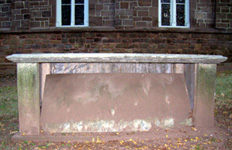

The Metlar-Bodine House in Piscataway, which was built in 1728 by Peter Bodine, is the oldest of two remaining buildings from the colonial port of Raritan Landing. In the 1890's, it was purchased by entepreneur George Metlar, who made the house his residence. Currently, historical artifacts, documents and exhibits are preserved in the house, which also doubles as a museum. The centerpiece of the collection is a wall preserved from Ross Hall, where George Washington celebrated Independence Day in 1778. From July 1st to the 7th of that year, General Washington and 11,000 Continental soldiers camped on the banks of the Raritan. Though Ross Hall no longer stands, the remnants of that time period are preserved at the Metlar House.
Of great interest to Rutgers Rarities was the fact that Jane Doherty, a renowned psychic, was brought into the Metlar House to investigate some paranormal behavior associated with the house. Ms. Doherty felt the presence of a great number of spirits in the house, including those tied to the Hall-Mills murder trial. On display in the Metlar House was an exhibit that contained the robe of the judge who tried the case. Ms. Doherty detected a presence in close proximity to this particular exhibit as well as other parts of the house.
Unfortunately, there was a fire in the Metlar House in 2003 that destroyed many historical artifacts. Firemen were able to save the house structure, and content from many of the rooms, but there was still a great deal of internal damage. The Rutgers Rarities investigation could not be extended to the interior of the house for this reason. Evaluation of the exterior showed signs that the house held up very well, with only a few examples of where smoke rose up through the doorways. From what could be seen through the windows, the walls and doors, however, were charred. This is a definite site for repeat investigations, as it will be interesting to note whether or not any more spirits remain since the fire. It is noted as one of the most prolific paranormal sites in the Rutgers area.
